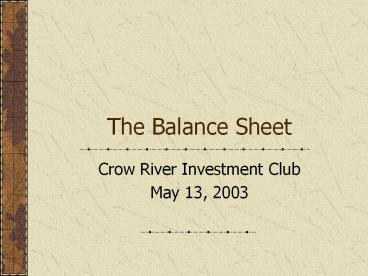The Balance Sheet - PowerPoint PPT Presentation
Title:
The Balance Sheet
Description:
The Balance Sheet Crow River Investment Club May 13, 2003 References Starting and Running a Profitable Investment Club Thomas E. O Hara Kenneth S. Janke, Sr. – PowerPoint PPT presentation
Number of Views:190
Avg rating:3.0/5.0
Title: The Balance Sheet
1
The Balance Sheet
- Crow River Investment Club
- May 13, 2003
2
References
- Starting and Running a Profitable Investment Club
Thomas E. OHara Kenneth S. Janke, Sr. - The Motley Fool Investment Workbook
- A Balance Sheet (in this case, Lowes)
- www.investorwords.com
3
Agenda
- Definitions
- What is a balance sheet?
- What do the terms mean?
- Analysis
- What do I look for?
4
What is it?
- Reports the financial condition of a company at a
specific point in time - Required to report every three months
- Three key areas
- Assets (What it owns)
- Liabilities (What it owes)
- Shareholders equity
- Assets Liabilities Shareholders Equity
5
Basic Terms - Assets
- Current Assets
- Can be turned into cash quickly (within 12
months) - Examples
- Cash, investments
- Accounts Receivable (Bills due to the company)
- Inventories
- Interest payments on cash in the bank
- Fixed Assets
- Also long-term assets, property, plant, and
equipment - Depreciation
Growth in these areas should generally not
outpace sales
6
Assets Example - LOW
- Current Assets FY02 FY01
- Cash and Cash Equivalents 853 799
- Short Term Investments 273 54
- Accounts Receivable Net 172 166
- Merchandise Inventory 3968 3611
- Deferred Income Taxes 58 93
- Other Current Assets 244 197
- Total Current Assets 5568 4920
- Property (Less Accumulated Depreciation) 10352
8653 - Long-Term Investments 29 22
- Other Assets 160 141
- Total Assets 16109 13736
7
Basic Terms Liabilities
- Current Liabilities
- Cash the company must pay in the next 12 months
- Examples
- Accounts Payable (Bills the company owes)
- Lease payments, short-term loans
- Accrued Taxes
- Accrued wages, interest, and other expense
- Long-term Liabilities
- Debt due in the years ahead vs. the current year
8
Liabilities Example - LOW
Current Liabilities FY02 FY01 Short Term
Borrowings 50 100 Current Maturities of LT
Debt 29 59 Accounts Payable 1943 1715 Empl
oyee Retirement Plans 88 126 Accrued Salaries
and Wages 306 221 Other Current
Liabilities 1162 796 Total Current
Liabilities 3578 3017 LT Debt (Excluding
Current Maturities) 3736 3734 Deferred Income
Taxes 478 305 Other LT Liabilities 15 6 To
tal Liabilities 7807 7062
9
So what?
- Whats good?
- Plenty of cash
- Non-cash current assets that are dropping
- Rising current liabilities (unpaid bills for
which cash is on hand) - Its better if the company is holding onto cash
as long as possible
- Whats bad?
- Rising Inventories
- Rising receivables
10
Basic Terms Shareholders Equity
- Represents the ownership of the company
- Common Stock
- Preferred Stock
- Surplus
- Capital or Paid-in surplus
- Retained Earnings or Earned Surplus
- Prepaid Expenses or deferred charges
- Intangible Assets
- Reserves for contingencies
11
Shareholders Equity Example - LOW
Shareholders Equity FY02 FY01 Preferred
Stock - 5 Par Value, none issued Common Stock -
.50 Par Value Shares Issued and
Outstanding January 31, 2003 782 February 1,
2002 776 391 388 Capital in Excess of Par
Value 2023 1803 Retained Earnings 5887
4482 Accumulated Other Comprehensive
Income 1 1 Total Shareholders
Equity 8302 6674 Total Liabilities and
Shareholders Equity 16109 13736
12
What to Look For
- Working Capital do they have liquidity to build
their business? - Current Assets Current Liabilities
- Current Ratio (Also Working Capital Ratio)
- Current Assets/Current Liabilities
- Acid Test excluded inventory and therefore
focuses on short-term obligations - Inventory Turnover
- COGS/Average Inventory at Cost
- If its increasing it means the company is
selling faster - Plant Turnover
- Sales/(Property, Plant, and equipment)
- Book Value more important to value investors
- Stated Value of the common stock retained
earnings surplus reserves
13
What to Look For
- Bond Ratio 30-40 is bad
- Preferred Stock Ratio
- Common Stock Ratio
- Leverage
- Ratio of bonds to preferred stock
- Long-Term Debt/Equity Ratio
- Shows how much creditors own versus shareholders
14
Ratios and Analysis Examples
- Working Capital
- FY02 8302 FY01 6674
- Current Ratio (Also Working Capital Ratio)
- FY02 2.1 FY01 1.9
- Book Value
- FY02 6278 FY01 4870
- LT Debt/Equity Ratio
- FY02 .45 FY01 .56
15
Next Month The Cash Flow Statement































